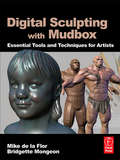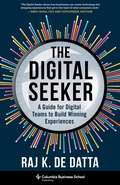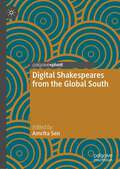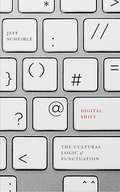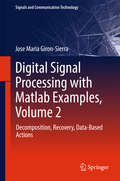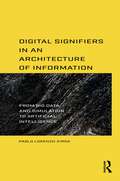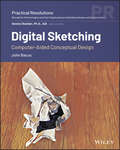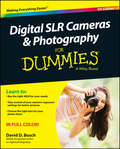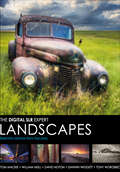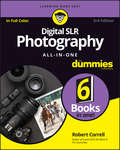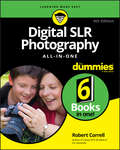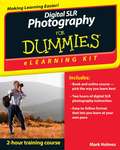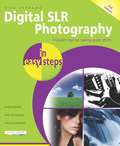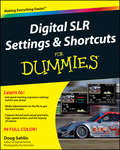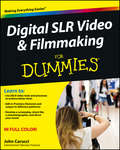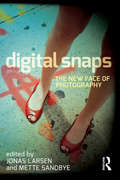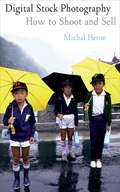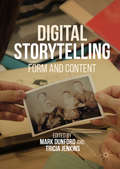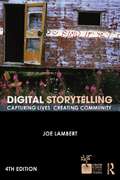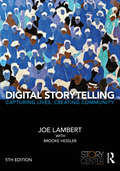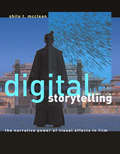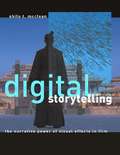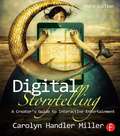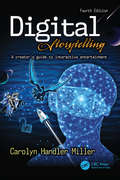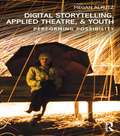- Table View
- List View
Digital Sculpting with Mudbox: Essential Tools and Techniques for Artists
by Bridgette Mongeon Mike de la FlorDigital sculpting is the use of tools to push, pull, smooth, grab, pinch or otherwise manipulate a digital object as if it were made of a real-life substance such as clay. Mudbox is the premier sculpting solution for digital artists, in that it allows them to naturally and easily sculpt detailed, organic characters and models in a way that feels like traditional sculpting.This book guides CG professionals through the process of creating amazing digital sculptures using the Mudbox arsenal of ground-breaking digital sculpting and 3D painting tools, and porting the models into their Maya or Max work.Artists will explore tried and true, traditional, sculpting techniques and learn to apply them to digital sculpting. A series of in-depth tutorials are incluced, each challenging them with progressively more complex models as they go on.Unique to this book are topics specific to fine art sculptors transitioning from traditional sculpting to digital sculpting. information found nowhere else for professional sculptors shows them how to successfully integrate digital sculpting into their workflow.Associated web site with: support files, models, materials, and textures for completing the tutorials in the book.
The Digital Seeker: A Guide for Digital Teams to Build Winning Experiences
by Raj K. DattaThe internet was supposed to connect us to endless possibilities. So why do we keep ending up browsing the same old sites and best-seller lists? When sellers don’t offer potential customers a compelling digital experience, consumers miss out on great products—and businesses miss a vital opportunity to grow.Raj K. De Datta, the founder of a company that powers digital-commerce experiences for many of the world’s biggest brands, offers an actionable playbook for companies looking to deliver better digital experiences. His key insight is that exceptional digital experiences are much more than marketplaces. They don’t just serve customers’ transactional needs but rather address the deeper problems for which they seek solutions. They are built on a digital-experience platform that provides agile, personalized, scalable performance. And they are created by product-centric digital teams, not traditional organizations.The Digital Seeker distills key lessons from the compelling stories of innovative businesses: not just tech companies but companies spanning a wide range of industries, including amusement parks, fashion, sports, health care, distribution, and the public sector. De Datta defines and explains the power of the seeker-centric philosophy—translating it into a core operational playbook for digital teams to achieve transformative results.Importantly, this book also offers crucial insights into the impact of the COVID-19 pandemic on our digital lives and the long-term effects it will have on digital experiences of the future.
Digital Shakespeares from the Global South (Global Shakespeares)
by Amrita SenDigital Shakespeares from the Global South re-directs current conversations on digital appropriations of Shakespeare away from its Anglo-American bias. The individual essays examine digital Shakespeares from South Africa, India, and Latin America, addressing questions of accessibility and the digital divide. This book will be of interest to students and academics working on Shakespeare, adaptation studies, digital humanities, and media studies.Included in this volume, the chapter on “Finding and Accessing Shakespeare Scholarship in the Global South: Digital Research and Bibliography” by Heidi Craig and Laura Estill is available open access under a Creative Commons Attribution 4.0 International License via link.springer.com.
Digital Shift
by Jeff ScheibleEmoticons matter. Equal signs do, too. This book takes them seriously and shows how and why they matter. Digital Shift explores the increasingly ubiquitous presence of punctuation and typographical marks in our lives using them as reading lenses to consider a broad range of textual objects and practices across the digital age. Jeff Scheible argues that pronounced shifts in textual practices have occurred with the growing overlap of crucial spheres of language and visual culture, that is, as screen technologies have proliferated and come to form the interface of our everyday existence. Specifically, he demonstrates that punctuation and typographical marks have provided us with a rare opportunity to harness these shifts and make sense of our new media environments. He does so through key films and media phenomena of the twenty-first century, from the popular and familiar to the avant-garde and the obscure: the mass profile-picture change on Facebook to equal signs (by 2.7 million users on a single day in 2013, signaling support for gay marriage); the widely viewed hashtag skit in Jimmy Fallon's Late Night show; Spike Jonze's Adaptation; Miranda July's Me and You and Everyone We Know; Ryan Trecartin's Comma Boat; and more. Extending the dialogue about media and culture in the digital age in original directions, Digital Shift is a uniquely cross-disciplinary work that reveals the impact of punctuation on the politics of visual culture and everyday life in the digital age.
Digital Signal Processing with Matlab Examples, Volume 2
by Jose Maria Giron-SierraThis is the second volume in a trilogy on modern Signal Processing. The three books provide a concise exposition of signal processing topics, and a guide to support individual practical exploration based on MATLAB programs.This second book focuses on recent developments in response to the demands of new digital technologies. It is divided into two parts: the first part includes four chapters on the decomposition and recovery of signals, with special emphasis on images. In turn, the second part includes three chapters and addresses important data-based actions, such as adaptive filtering, experimental modeling, and classification.
Digital Signifiers in an Architecture of Information: From Big Data and Simulation to Artificial Intelligence
by Pablo Lorenzo-EiroaThis book proposes a new critical relationship between computation and architecture, developing a history and theory of representation in architecture to understand and unleash potential means to open up creativity in the field. Historically, architecture has led to spatial representation. Today, computation has established new representational paradigms that can be compared to spatial representations, such as the revolution of perspective in the Renaissance. Architects now use software, robotics, and fabrication tools with very little understanding and participation in how these tools influence, revolutionize, and determine both architecture and its construction today. Why does the discipline of architecture not have a higher degree of authorship in the conception and development of computational technologies that define spatial representation? This book critically explores the relationship between history, theory, and cultural criticism. Lorenzo-Eiroa positions new understandings through parallel historical sections and theories of many revolutionary representational architecture canons displaced by conventional spatial projection. He identifies the architects, artists, mathematicians, and philosophers that were able to revolutionize their disciplines through the development of new technologies, new systems of representation, and new lenses to understand reality. This book frames the discussion by addressing new means to understand and expand architecture authorship in relation to the survey, information, representation, higher dimensional space, Big Data, and Artificial Intelligence – in the pursuit of activating an architecture of information. This will be important reading for upper-level students and researchers of architecture and architectural theory, especially those with a keen interest in computational design and robotic fabrication.
Digital Sketching: Computer-Aided Conceptual Design (Practical Revolution)
by John BacusLearn to apply new digital design technologies at your own firm with this practical and insightful resource Digital Sketching: Computer-Aided Conceptual Design delivers a comprehensive and insightful examination of how architects and other design professionals can best use digital design technology to become better designers. Celebrated professional, professor, and author John Bacus provides readers with practical and timely information on emerging digital design technologies and their effect on professional practice. By focusing on the big picture, this rigorous survey of conceptual design technology offers professionals realistic strategies for reclaiming time for design in the ever increasing speed of project delivery. This book helps architects (and others like them) learn to use digital sketching techniques to be better designers, right from the project’s very first sketch. As part of the groundbreaking Practical Revolutions series of books, Digital Sketching furthers the conversation of the practical deployment of emerging technologies in the building industries. This book provides readers with the information they need to evaluate digital design technology and decide whether or not to adopt and integrate it into their own processes. Readers will receive: An accelerated and accessible introduction to a highly technical topic Practical and applicable guidance on how to adapt a firm’s business to adopt new technology without losing the benefit of existing intuition, skill, and experience. Real world implementations of specific techniques in the form of illuminating case studies that include results and lessons learned Perfect for professional architectural designers, Digital Sketching also belongs on the bookshelves of interior designers, landscape architects, urban planners, contractors, and specialty fabricators of every kind. A disciplined sketching practice, especially through the digital methods discussed in this book, is a transformational benefit to anyone who designs and builds for a living.
Digital SLR Cameras and Photography For Dummies
by David D. BuschThe perennial digital photography bestseller, now updated to cover the hottest topicsDigital SLR Cameras & Photography For Dummies has been a bestseller since it first came into the picture, and this new edition gets you up to (shutter) speed on the latest technologies available. Veteran author David Busch walks you through new camera models from the leading manufacturers, WiFi and GPS options, full HD moviemaking, and the latest dSLR features. He also provides you with a solid foundation of knowledge about exposure, composition, and lighting that any new dSLR user needs to know to get great results from the camera.The straightforward-but-friendly coverage offers tips for choosing a camera and accessories, using different controls, maximizing lighting and exposure, and editing your photos. With this helpful book by your side, you'll learn your way around shutter speed, aperture, and ISO so that you can get a handle on the big picture while you take pictures!Introduces you to all the features common to dSLR cameras, whether it's Canon, Nikon, Sony, Pentax, Olympus, or another digital SLR cameraShares tips on composition, lighting and exposure controls, and file formats Shows you how to get photos from your camera to a computer and then how to manage, edit, and share your picsOffers hints on improving your skills, online resources, and the jargon of the prosIf you're ready to get in the dSLR picture, then this is the book you need.
The Digital SLR Expert Landscapes: Expert advice from top pros (The Digital SLR Expert)
by VariousHEADLINE: Build and Refine Your In-Camera and Photoshop Skills with This Authoritative and Visually Stunning Guide to Capturing Incredible Landscape Photographs Practical demonstrations, step-by-step examples and invaluable secrets from five leading professional photographers show you how to use your digital SLR to its full potential Darwin Wiggett, David Noton, William Neill, Tom Mackie and Tony Worobiec tackle subjects key to taking great landscape images: controlling exposure; understanding light; composing shots; choosing the perfect location and working in black and white Breathtaking photography showcases a wide variety of landscape locations from coasts to mountains, cities to countryside and deserts to forests, highlighting the versatility and full potential of digital photography
Digital SLR Photography All-in-One For Dummies
by Robert CorrellThe bestselling guide to DSLR photography - now updated for the latest technology and tools!This new edition gets you up to "shutter speed" on the latest camera technologies, including the new consumer-targeted full-frame models and pro-features that are now incorporated in consumer-focused units. Veteran author and professional photographer Robert Correll walks you through how a camera works, what lenses to use, how to set exposure, and how to capture the shots that define a portfolio.Fully updated to cover the latest generation of cameras and boasting more than 700 pages, this must-have resource explores the latest in tools and offers additional content, including video and interactive tools so that you can enhance your photography knowledge. Covers the basics of DSLR mechanics and explains how settings affect the final photoReviews lenses and walks you through choosing and applying the right lens for your situationDiscusses how aperture, shutting speed, and ISO combine to determine how your photo will lookDemystifies how to light a photo, from using natural light to flash to artificial lightingHelps you shooting high-quality video and filmDigital SLR Photography All-in-One For Dummies, 2nd Edition is packed with everything you need to get your idea photo, from portraits to action shots to night photos and so much more!
Digital SLR Photography All-in-One For Dummies
by Robert Correll6 Books in one! Boost your DSLR photography skills with this amazing book When you're investing in top-notch camera equipment, it's also time to build top-notch photography skills that help you create the stunning images you see in your mind. This book gets you started on the path to capturing incredible photos of life's most precious moments. Cut through the jargon and techspeak as you get down to the essentials of taking control of your powerful camera and leaving the days of washed-out and blurry photos behind. 6 Books Inside… Review digital photography basics and camera controls Get the right lens for the shot Take creative control of exposure settings Shed some light on your subject Perfect the picture with editing Follow recipes for portraits, landscapes, close-ups, and action shots
Digital SLR Photography eLearning Kit For Dummies
by HolmesUnderstand and use digital SLR cameras with this complete photography courseIf you're making the switch from simple point-and-shoot cameras to more complex dSLRs and hoping to enhance your photography skills along the way, make your next purchase this value-packed eLearning kit. This complete dSLR photography course includes a full-color printed book and a Dummies interactive eLearning course on CD. You'll find a wealth of information on such topics as how to set your camera's exposure controls, composition do's and don't's, and how to apply what you're learning so you take better pictures.Follow the material sequentially or jump in and out as you wish?it's set up so you can learn at your own pace. Throughout, you will benefit from illustrations, animations, voiceover explanations, and the option of closed captioning if you find you learn better when you can read the instructions.Helps self-motivated learners master digital SLR photography equipment, concepts, terms, and picture-taking basics Includes an easy-to-follow, full-color book and an interactive Dummies eLearning Course that corresponds with the book on CD Allows you to follow the material sequentially or choose separate sections at your own time and pace Offers chapter summaries, practice exercises, discussions of concepts and essential terms, and much more Get the very most out of your dSLR camera and your photography with Digital SLR Photography eLearning Kit For Dummies.NOTE:CD-ROM/DVD and other supplementary materials are not included as part of the e-book file, but are available for download after purchase.
Digital SLR Photography in Easy Steps
by Nick VandomeDigital SLR Photography in Easy Steps begins by demystifying digital cameras and explaining their functions and capabilities. Then, it'll guide the reader in buying the right camera for his/her purpose. It'll take the reader through each key function of a digital SLR camera, step-by-step, in digestable chunks.Covering areas such as exposure, shutter speed, aperture, lighting and focusing the book shows how this technical knowledge can be harnessed with a digital SLR to produce images of which you will be proud. In addition, areas such as landscapes, architecture and people are looked at so that you can use your digital SLR to maximum creative effectBut Digital SLR Photography in Easy Steps is much more than a guide to the functions and use of digital SLR cameras. One of its main purposes is to show how to use these powerful and flexible cameras to improve your creative skills, so that you see yourself more as a photographer rather than someone who just takes snapshots.This second edition includes a whole new chapter on Clever Photography Techinques to get the reader started like a Pro!
Digital SLR Settings and Shortcuts For Dummies
by Doug SahlinDiscover the easy path to taking brilliant and memorable photosThe popularity of DSLR cameras remains on the rise, yet these digital cameras still present a challenge to novice photographers who lack a foundation in photography skills. This straightforward-but-friendly guide walks you through the 100 most common photos that amateur photographers like to include in their personal portfolios and offers specific advice on getting the correct exposure settings, composition, and lighting while sparing you the technical jargon. Seasoned author and photographer Doug Sahlin includes more than 300 full-color photos on everything from family portraits and pets to nature and sporting events, all aimed at providing you with inspiration as you work to find your own individual style. Skips the technical jargon and shows you where to start for optimal exposure settings.Offers shortcuts, tips, and advice for setting the camera to make specific shots and making impromptu adjustments when neededIncludes more than 300 full-color photos of people, nature, sports, events, and places that serve as example and inspirationHelps you get the best photographs from your DSLR while you work with movement in action photos, finicky lighting with fireworks or amusement parks at night, or distance, blur, and intricate detailsWalks you through troubleshooting the most common digital photography problemsDigital SLR Settings & Shortcuts For Dummies delivers the starting point for getting the necessary settings so you can get great digital photos.
Digital SLR Video and Filmmaking For Dummies
by John CarucciStep-by-step guide for using your digital SLR to make quality videoWith digital SLR cameras becoming more and more popular as replacements for standalone video cameras, this book helps photographers become better videographers and shows videographers how to incorporate DSLRs into their work. The book includes an overview of the DSLR video tools and process and shows how to establish camera settings for effective capture, light a scene, get sound, and achieve the film look. The book also offers the basics on editing footage into a final product using common video editing tools.Offers everything needed to shoot, produce, and edit a professional looking videos using DSLR video equipment Written for both professional photographers and videographers and those just starting out Includes the steps for applying information to a film project, including developing a screenplay, approaching shooting like a cinematographer, and directing Contains a walkthrough of common video projects including making a music video, a wedding video, and video greeting cardDigital SLR Video and Filmmaking for Dummies is designed to help photographers ramp up their video skills, videographers add DSLRs to their toolkits, and amateurs begin shooting their own short films and videos.
Digital Snaps: The New Face of Photography (International Library Of Visual Culture Ser. #Vol. 7)
by Jonas LarsenPhotography as an everyday practice is once again changing dramatically. At this moment of transition from analogue to digital, Digital Snaps aims to develop a new media ecology that can accommodate these changes to photography 'as we know it'. Expert contributors representing varied disciplines demonstrate how and to what extent the traditional social practices, technologies and images of analogue photography are being transformed with the movement to digital photography. They zoom in on typical, vernacular, everyday practices: the development of the family photo album from a physical object in the living room to a digital practice on the Internet; the use of mobile phones in everyday life; photo communities on the Internet; photo booth photography; studio photography; and fine arts' appropriation of amateur photography. They explore how this media convergence transforms the media ecology - the networks, objects, performances, meanings and circulations - of vernacular photography, as we research it through ordinary people's use of such new cameras and interactive Internet spaces as part of their everyday lives.
Digital Stock Photography: How to Shoot and Sell
by Michal HeronThis volume details how to create salable digital stock photos, covering style and the process of shooting, preparation, and editing and post-production. Other chapters discuss running a business, marketing, finding an agency, negotiating prices, copyright, and model releases and business forms, and one chapter contains 25 stock assignments and details on each. The volume is based on the third edition of How to Shoot Stock Photos That Sell, and some information has been revised and adapted. Other sections are new. Heron is a freelance photographer and the author of other books on the subject. Annotation ©2008 Book News, Inc., Portland, OR (booknews.com)
Digital Storytelling: Form and Content
by Tricia Jenkins Mark DunfordThis edited collection brings together academics and practitioners to explore the uses of Digital Storytelling, which places the greatest possible emphasis on the voice of the storyteller. Case studies are used as a platform to investigate questions of concept, theory and practice, and to shine an interrogative light on this emergent form of participatory media. The collection examines the creative and academic roots of Digital Storytelling before drawing on a range of international examples to consider the way in which the practice has established itself and evolved in different settings across the world.
Digital Storytelling
by Joe LambertListen deeply. Tell stories. This is the mantra of the Center for Digital Storytelling (CDS) in Berkeley California, which, since 1998 has worked with nearly 1,000 organizations around the world and trained more than 15,000 people in the art of digital storytelling. In this revised and updated edition of the CDS's popular guide to digital storytelling, co-founder Joe Lambert details the history and methods of digital storytelling practices. Using a "7 Steps" approach, Lambert helps storytellers identify the fundamentals of dynamic digital storytelling--from seeing the story, assembling it, and sharing it. As in the last edition, readers of the fourth edition will also find new explorations of the applications of digital storytelling and updated appendices that provide resources for budding digital storytellers, including information about past and present CDS-affiliated projects and place-based storytelling, a narrative-based approach to understanding experience and landscape. A companion website further brings the entire storytelling process to life. Over the years, the CDS's work has transformed the way that community activists, educators, health and human services agencies, business professionals, and artists think about story, media, culture, and the power of personal voice in creating change. For those who yearn to tell multimedia stories, Digital Storytelling is the place to begin.
Digital Storytelling: Capturing Lives, Creating Community
by Joe Lambert Brooke HesslerIn this revised and updated edition of the StoryCenter's popular guide to digital storytelling, StoryCenter founder Joe Lambert offers budding storytellers the skills and tools they need to craft compelling digital stories. Using a "Seven Steps" approach, Lambert helps storytellers identify the fundamentals of dynamic digital storytelling – from conceiving a story, to seeing, assembling, and sharing it. Readers will also find new explorations of the global applications of digital storytelling in education and other fields, as well as additional information about copyright, ethics, and distribution. The book is filled with resources about past and present projects on the grassroots and institutional level, including new chapters specifically for students and a discussion of the latest tools and projects in mobile device-based media. This accessible guide’s meaningful examples and inviting tone makes this an essential for any student learning the steps toward digital storytelling.
Digital Storytelling: The Narrative Power of Visual Effects in Film (The\mit Press Ser.)
by Shilo T. McCleanHow digital visual effects in film can be used to support storytelling: a guide for scriptwriters and students.Computer-generated effects are often blamed for bad Hollywood movies. Yet when a critic complains that "technology swamps storytelling" (in a review of Van Helsing, calling it "an example of everything that is wrong with Hollywood computer-generated effects movies"), it says more about the weakness of the story than the strength of the technology. In Digital Storytelling, Shilo McClean shows how digital visual effects can be a tool of storytelling in film, adding narrative power as do sound, color, and "experimental" camera angles—other innovative film technologies that were once criticized for being distractions from the story. It is time, she says, to rethink the function of digital visual effects.Effects artists say—contrary to the critics—that effects always derive from story. Digital effects are a part of production, not post-production; they are becoming part of the story development process. Digital Storytelling is grounded in filmmaking, the scriptwriting process in particular. McClean considers crucial questions about digital visual effects—whether they undermine classical storytelling structure, if they always call attention to themselves, whether their use is limited to certain genres—and looks at contemporary films (including a chapter-long analysis of Steven Spielberg's use of computer-generated effects) and contemporary film theory to find the answers. McClean argues that to consider digital visual effects as simply contributing the "wow" factor underestimates them. They are, she writes, the legitimate inheritors of film storycraft.
Digital Storytelling
by Shilo T. MccleanComputer-generated effects are often blamed for bad Hollywood movies. Yet when a critic complains that "technology swamps storytelling" (in a review of Van Helsing, calling it "an example of everything that is wrong with Hollywood computer-generated effects movies"), it says more about the weakness of the story than the strength of the technology. In Digital Storytelling, Shilo McClean shows how digital visual effects can be a tool of storytelling in film, adding narrative power as do sound, color, and "experimental" camera angles--other innovative film technologies that were once criticized for being distractions from the story. It is time, she says, to rethink the function of digital visual effects. Effects artists say--contrary to the critics--that effects always derive from story. Digital effects are a part of production, not post-production; they are becoming part of the story development process. Digital Storytelling is grounded in filmmaking, the scriptwriting process in particular. McClean considers crucial questions about digital visual effects-- whether they undermine classical storytelling structure, if they always call attention to themselves, whether their use is limited to certain genres--and looks at contemporary films (including a chapter-long analysis of Steven Spielberg's use of computer-generated effects) and contemporary film theory to find the answers. McClean argues that to consider digital visual effects as simply contributing the "wow" factor underestimates them. They are, she writes, the legitimate inheritors of film storycraft.
Digital Storytelling: A creator's guide to interactive entertainment
by Carolyn Handler MillerDigital Storytelling shows you how to create immersive, interactive narratives across a multitude of platforms, devices, and media. From age-old storytelling techniques to cutting-edge development processes, this book covers creating stories for all forms of New Media, including transmedia storytelling, video games, mobile apps, and second screen experiences. The way a story is told, a message is delivered, or a narrative is navigated has changed dramatically over the last few years. Stories are told through video games, interactive books, and social media. Stories are told on all sorts of different platforms and through all sorts of different devices. They’re immersive, letting the user interact with the story and letting the user enter the story and shape it themselves. This book features case studies that cover a great spectrum of platforms and different story genres. It also shows you how to plan processes for developing interactive narratives for all forms of entertainment and non-fiction purposes: education, training, information and promotion. Digital Storytelling features interviews with some of the industry’s biggest names, showing you how they build and tell their stories.
Digital Storytelling 4e: A creator's guide to interactive entertainment
by Carolyn Handler MillerThis fourth edition of Digital Storytelling: A creator's guide to interactive entertainment dives deeply into the world of interactive storytelling, a form of storytelling made possible by digital media. Carolyn Handler Miller covers both the basics – character development, structure and the use of interactivity – and the more advanced topics, such as AI (Artificial Intelligence), narratives using AR and VR, and Social Media storytelling. The fourth edition also includes a greatly expanded section on immersive media, with chapters on the exciting new world of the world of XR (AR, VR, and mixed reality), plus immersion via large screens, escape rooms and new kinds of theme park experiences. This edition covers all viable forms of New Media, from video games to interactive documentaries. With numerous case studies that delve into the processes and challenges of developing works of interactive narrative, this new edition illustrates the creative possibilities of digital storytelling. The book goes beyond using digital media for entertainment and covers its employment for education, training, information and promotion, featuring interviews with some of the industry’s biggest names. Key Features: A large new section covering various forms of immersive media, including VR, AR and Mixed Reality Breakthroughs in interactive TV and Cinema The use of VR, AR and mixed reality in gaming New forms of voice-enabled storytelling and gaming Stories told via mobile apps and social media Developing Digital Storytelling for different types of audiences
Digital Storytelling, Applied Theatre, & Youth: Performing Possibility
by Megan AlrutzDigital Storytelling, Applied Theatre, & Youth argues that theatre artists must re-imagine how and why they facilitate performance practices with young people. Rapid globalization and advances in media and technology continue to change the ways that people engage with and understand the world around them. Drawing on pedagogical, aesthetic, and theoretical threads of applied theatre and media practices, this book presents practitioners, scholars, and educators with innovative approaches to devising and performing digital stories. This book offers the first comprehensive examination of digital storytelling as an applied theatre practice. Alrutz explores how participatory and mediated performance practices can engage the wisdom and experience of youth; build knowledge about self, others and society; and invite dialogue and deliberation with audiences. In doing so, she theorizes digital storytelling as a site of possibility for critical and relational practices, feminist performance pedagogies, and alliance building with young people.
